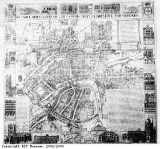Bristol as a trading port
The city of Bristol in the west of England is situated on the River Avon and the River Frome. The Avon flows into the River Severn and from there into the Bristol Channel before joining the North Atlantic Ocean. Bristol has a long trading history due to its position on the River Avon. The Roman army had a port here 2,000 years ago.
Bristol developed into one of the major trading ports in Britain. From at least the 14th century, Bristol was the second English city after London. The city held this position because of the economic importance of the port of Bristol. Trade at this time was based mainly on the woollen cloth produced in the surrounding counties of Somerset, Goucestershire, Devon and Dorset. Bristol’s merchants were trading with Europe from at least the 11th century. To support the expansion of trade, Bristol had a shipbuilding industry and a financial industry, as well as a network of merchants with contacts in different countries. The surrounding area produced goods to trade. Bristol’s merchants were keen, and always looking for new areas of trade. When the opportunity came to join the developing trade to Africa and the Americas, they seized the chance.
Pictured here is The Citty of Bristoll by James Millerd, 1673. It shows the River Frome running behind the area of Bristol known as the Marsh. The River Avon, also seen on this picture, is the main channel running through the city.




